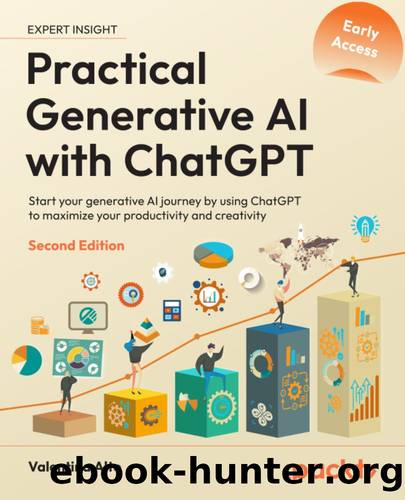Practical Generative AI with ChatGPT by Unknown

Author:Unknown
Language: eng
Format: epub
Tags: openai; chatgpt book; llms; ai books; prompt engineering; time management; do it today
Publisher: Packt Publishing
Published: 2025-02-27T00:00:00+00:00
Improving writing skills and translation
Sometimes, rather than generating new content, you might want to revisit an existing piece of text. It this be for style improvement purposes, audience changes, language translation, and so on.
Letâs look at some examples. Imagine that I drafted an email to invite a customer of mine to a webinar. I wrote two short sentences. Here, I want ChatGPT to improve the form and style of this email since the target audience will be executive level:
Figure 5.12 â Example of an email revisited by ChatGPT to target an executive audience Now, letâs ask the same thing but with a different target audience:
Figure 5.13 â Example of the same email with a different audience, generated by ChatGPT ChatGPT can also give you some feedback about your writing style and structure.
Imagine, for example, that you wrote an introduction for an essay titled The History of Natural Language Processing and you want some feedback about the writing style and its consistency with the title:
Figure 5.15 â Example of ChatGPT giving feedback on an introduction for an essay As you can see, not only ChatGPT provided me with feedback and tips for the overall essay, but also it gave me a revised introduction which incorporates all of them.
Letâs also ask ChatGPT to be more specific regarding its suggestion of âRefining Examplesâ:
Figure 5.16 â Example of ChatGPT elaborating on something it mentioned Iâm also interested in knowing whether my introduction was consistent with the title or whether Iâm taking the wrong direction:
Figure 5.17 â ChatGPT provides feedback about the consistency of the introduction with the title I was impressed by this last one. ChatGPT was smart enough to see that there was no specific mention of the history of NLP in my introduction. Nevertheless, it sets up the expectation about that topic to be treated later on. This means that ChatGPT also has expertise in terms of how an essay should be structured and it was very precise in applying its judgment, knowing that it was just an introduction.
Letâs now unveil the last ChatGPT skill of the Chapter. In fact, ChatGPT is also an excellent tool for translation. It knows at least 95 languages (if you have doubts about whether your language is supported, you can always ask ChatGPT directly). Here, however, there is a consideration that might arise: what is the added value of ChatGPT for translation when we already have cutting-edge tools such as Google Translate?
To answer this question, we have to consider some key differentiators and how we can leverage ChatGPTâs embedded translations capabilities:
ChatGPT can capture the intent. This means that you could also bypass the translation phase since it is something that ChatGPT can do in the backend. For example, if you write a prompt to produce a social media post in French, you could write that prompt in any language you want â ChatGPT will automatically detect it (without the need to specify it in advance) and understand your intent:
Figure 5.18 â Example of ChatGPT generating an
Download
This site does not store any files on its server. We only index and link to content provided by other sites. Please contact the content providers to delete copyright contents if any and email us, we'll remove relevant links or contents immediately.
| Computer Vision & Pattern Recognition | Expert Systems |
| Intelligence & Semantics | Machine Theory |
| Natural Language Processing | Neural Networks |
Algorithms of the Intelligent Web by Haralambos Marmanis;Dmitry Babenko(16234)
Jquery UI in Action : Master the concepts Of Jquery UI: A Step By Step Approach by ANMOL GOYAL(9386)
Test-Driven Development with Java by Alan Mellor(7735)
Data Augmentation with Python by Duc Haba(7608)
Principles of Data Fabric by Sonia Mezzetta(7378)
Learn Blender Simulations the Right Way by Stephen Pearson(7294)
Microservices with Spring Boot 3 and Spring Cloud by Magnus Larsson(7137)
Hadoop in Practice by Alex Holmes(6587)
RPA Solution Architect's Handbook by Sachin Sahgal(6515)
The Infinite Retina by Robert Scoble Irena Cronin(6216)
Big Data Analysis with Python by Ivan Marin(5933)
Life 3.0: Being Human in the Age of Artificial Intelligence by Tegmark Max(5512)
Pretrain Vision and Large Language Models in Python by Emily Webber(4894)
Infrastructure as Code for Beginners by Russ McKendrick(4653)
Functional Programming in JavaScript by Mantyla Dan(4436)
WordPress Plugin Development Cookbook by Yannick Lefebvre(4382)
The Age of Surveillance Capitalism by Shoshana Zuboff(4243)
Embracing Microservices Design by Ovais Mehboob Ahmed Khan Nabil Siddiqui and Timothy Oleson(4146)
Applied Machine Learning for Healthcare and Life Sciences Using AWS by Ujjwal Ratan(4135)
